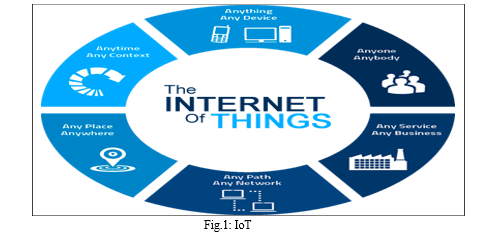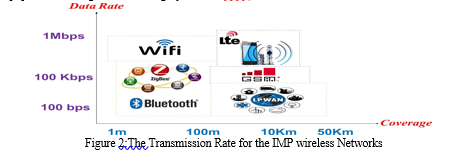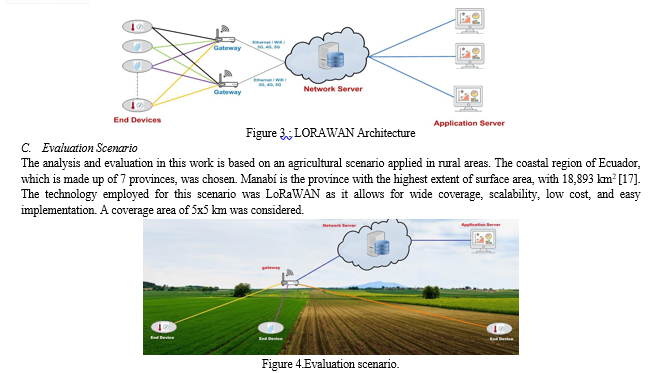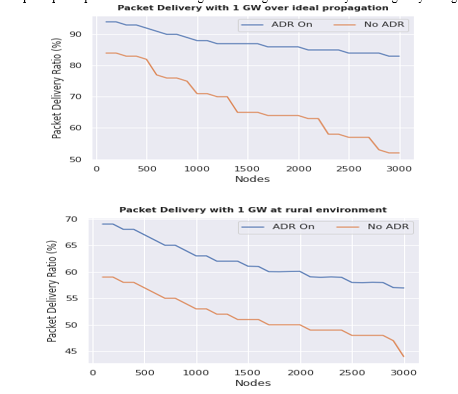Ijraset Journal For Research in Applied Science and Engineering Technology
- Home / Ijraset
- On This Page
- Abstract
- Introduction
- Conclusion
- References
- Copyright
Internet of Things - Novel Application in Agriculture
Authors: Gangapurwala Monika Prashant , Gangapurwala Pratik P.
DOI Link: https://doi.org/10.22214/ijraset.2024.61652
Certificate: View Certificate
Abstract
In the Present Era, the world is experiencing a strong rush towards modern technology, while specialized companies are living a terrible rush in the information and Communication technology towards the so-called Internet of things IoT or Internet of objects, which is the integration of things with the world of Internet, by adding hardware or/and software to be smart and so is able to communicate with each other and participate effectively in all aspects of daily life. By enabling new forms of communication between people and things, and between things themselves, that will change the traditional life into a high style of living. But it won’t be easy, because there are still many challenges and issues that need to be addressed and have to be viewed from various aspects to realize their full potential. The main objective of this paper is to provide the reader with a detailed discussion from a technological and social perspective. The various IoT aspects, definition and architecture, challenges and issues were discussed. Furthermore, a description of several sensors and actuators and their smart communication. Also, the most important application areas of IoT were presented with a case study. This work will help readers and researchers understand the IoT and its potential application in the real world.
Introduction
I. INTRODUCTION
The term Internet of Things (IoT) was invented by industry researchers but has surfaced into mainstream public view only more recently. Some maintain the Internet of Things will entirely transform how computer networks are used for the next 10 or 100 years, while others consider IoT is just hype that won't much impact the daily lives of most people. The "Internet of things" (IoT) is becoming an increasingly growing topic of conversation both in the workplace and outside of it. It's a concept that not only has the potential to impact how we live but also how we work. The Internet of things creates an opportunity to evaluate, assemble and analyze an ever- increasing selection of behavioral information.
It is expected that IoT devices will be incorporated into all forms of energy consuming devices such as switches, bulbs, power outlets, televisions, etc. and be proficient to communicate with the utility supply company in order to efficiently balance power generation and energy consumption
II. LITERATURE SURVEY
The Internet of Things (IoT) is a term coined by Kevin Ashton, who perceived a system of ubiquitous sensors concerning the physical world to the Internet. Though things, Internet, and connectivity are the three core factors of Internet of Things (IoT), the importance is in closing the breach between the physical and digital world in self-reinforcing and self-improving techniques. [4]. Internet of Things definition is the vast network of devices connected to the Internet, including smart phones and tablets and almost anything with a sensor on it – cars, machines in production plants, jet engines, oil drills, wearable devices, and more. These “things” collect and exchange data. IoT – and the machine-to-machine (M2M) technology behind it – are bringing a kind of “super visibility” to nearly every industry. Imagine utilities that can predict and prevent service outages, airlines that can remotely monitor and optimize plane performance, and healthcare organizations that can base treatment on real-time genome analysis. The business possibilities are endless. Internet of Things symbolizes a general perception for the ability of network devices to sense and collect data from the world, and then contribute that data across the Internet where it can be processed and developed for various interesting reasons. [1]. The Internet-of-Things (IoT) is steadily becoming one of the most outstanding technologies that emphasize this world, through facilitate the orchestration and coordination of a large number of physical and virtual Internet-Connected-Objects (ICO) towards human-centric services in a selection of sectors counting logistics, industry, trade, smart cities and ambient supported living as shown in Figure1. Furthermore, we will be presenting a set of internet-of-things technologies and applications in the form of a series of knowledge.
it’s going to be a major engine for creating new products and new services. Of all the technology trends that are taking place right now, perhaps the biggest one is the Internet of Things; it’s the one that’s going to give us the most disruption as well as the most opportunity over the next five years. In my next post in this two-part series, we’ll explore just how big this is going to be . In order to realize the benefits of IoT, such as increasing customer intimacy, improving operational excellence and generating new revenue streams through business model innovation; there are three critical components for the ecosystem to thrive: reliable connectivity, reliable security and an agile monetization framework.

Broadband internet is becoming more widely available, the cost of connecting is decreasing, more devices are being created with Wi-Fi capabilities and sensors built into them, technology costs are going down, and smartphone penetration is skyrocketing.
The propagation of internet-connected-objects authorizes interactions both between devices and things but also between things and people, hence providing unparalleled application prospects. Definitely, people can directly connect to things such as mobile phones, electronic health records and many more things, via wearable sensors such as motion sensors and smart textiles. Similarly, things connect to each other e.g., as part wireless sensor networks, but also as part of a Wireless Sensor Network's communication with other devices such as gateways, mobile devices etc. Another example is car sensors, which connect to intelligent transport systems and with sensors from other mediums. These communications are in most cases empowered by various networking frameworks, which offer ubiquitous high-quality connectivity, such as 4G and 5G infrastructures [2]. Cloud-based applications are the key to using leveraged data. The Internet of Things doesn’t function without cloud-based applications to interpret and transmit the data coming from all these sensors. The cloud is what enables the apps to go to work for you anytime, anywhere. Here’s what I mean when I say people never think big enough. This isn’t just about money savings. It’s not about bridges, and it’s not about cities. This is a huge and fundamental shift. When we start making things intelligent,
Anyone who says that the Internet has basically improved society may be right but at the same time, the ultimate transformation essentially still lies ahead of us. Numerous innovative technologies are now joining in a way that means the Internet is on the edge of a generous development as objects large and small get connected and simulate their own web uniqueness. Succeeding on from the Internet of computers when our servers and personal computers were linked to an inclusive network system, and the Internet of mobile systems, while it was the turn of telephones and other mobile components, the next stage of development is the Internet of things (IoT), when more or less everything will be connected and accomplished in the virtual domain. [3] This revolution will be the Internet’s largest expansion ever and will have sweeping conclusions on every industry, and all of our everyday lives.
III. CASE STUDY
The Food and Agriculture Organization of the United Nations (FAO) has estimated that by the year 2050 the global population will reach 9.7 Billion People. It is foreseen for the decade 2050-2060 one third of population will live in od on the Automation Processes. Another investigations have focused on improving production systems. Advances in technological and communication solutions allow for monitoring of field conditions in agricultural sectors through use of various systems using sensors that acquire data.
These acquisition systems allow local Transmission of information by IoT Technology based on Internet connectivity [5,6] Various communication Protocols such as RFID/WiFi/Bluetooth are used for monitoring variables related to the agriculture sector as shown in Figure 2. Wimax and LTE/4G [7]are the most commonly used due to the Long Range feature.5G,6G,LPWAN,LORAWAN are used due to their advantages. LPWAN and LORAWAN’s use in agriculture is considered for Analysis.
A. LP WAN Analysis: Technologies
The IoT boom in recent years has led to an increase in the number of connected devices, giving rise to new technologies capable of interconnecting large numbers of levels, among others. These collected data are stored in the cloud for later use and decision making [8].
With the continuous growth of devices with Internet connectivity, IoT applications require long-range communication technologies, large-scale connectivity, low energy con- sumption, and low cost. LPWAN technologies have the required parameters to cover these needs [9].
Current wireless communication technologies such as Bluetooth and ZigBee have a short range, while cellular communication technologies (e.g., 3G, 4G, and 5G) have a medium range but are limited by high power consumption; however, this limitation has been mitigated with the emergence of LPWAN long-range technologies that have lower energy consumption [10]. Figure 1 shows the relationship between coverage and data transmission rate for the most important wireless networks. LPWAN technologies are wireless networks that allow for the transmission of small amounts of data over long distances with low power consumption on their final devices. The technologies also provide connectivity for a large number of devices, making them ideal candidates for IoT applications [11].
Several types of LPWAN technologies are currently available, some using licensed frequencies, and others operating in unlicensed spectra. The most popular technologies in this category include LoRa [12,13] and NB-IoT [14],

each with their own unique technical features LoRa has advantages in terms of cost, battery life, and implementation; furthermore, it is commercially available in several countries. For these reasons, we focus on the use of this technology, which is adapted to the conditions of rural areas, making it particularly suited to agricultural applications. Implementation of LoRa will allow for the connection of a large number of devices over a long range with low power consumption, favoring the monitoring of climate variables, water consumption in irrigation systems, and crop fertilization. These parameters are expected to allow for improvements in the quality of products.
B. LoRaWAN Architecture:
The LoRaWAN architecture uses a star network topology, which allows for ease of implementation and management as there is no need for routing elements.The devices that make up a LoRaWAN network are: end devices (e.g., sensors and actuators), gateways, network servers, and application servers [15]. Its operation starts when the end devices send encrypted messages to the gateways, which then forward information to the network server using TCP/IP protocols. In this way, the network server receives and processes information from the end devices, discarding messages that were received more than once from different gateways. Additionally, the network server is responsible for security between the end device and the application server. The application server decrypts messages and makes information available to the user [16]. In Figure 3, we show the architecture of a LoRaWAN network. Additionally, LoRaWAN allows for two-way communication through LoRa.
Some of the particular features of the chosen agricultural environment are:
- Large areas of land with few obstacles or interferences from other networks as is often the case in urban environments;
- High density of devices, which should be placed a few meters apart to achieve better resolution of data from climate monitors on crops;
- Low heterogeneity of the data collected; this means that only a few climatic parameters, such as humidity, temperature, and so on, need to be acquired. For this reason, similar devices are needed for the implementation of the network.
For each measurement presented, the simulation window time was 1 day, and we ran the simulation five times. The results shown in this paper are the average of the five trials. We performed a simulation to measure the scalability of the LoRa/LoRaWAN network; so sensor data were not included in the simulation. Therefore, the size of each transmitted data packet was constant (i.e., 10 bytes long).
To evaluate the proposed scenario, a simulator called Omnet++ was used. This simulator includes a library of open code called FLoRa, developed by researchers at Aalto University in Finland for their studies on LoRa and LoRaWAN [18]. This simulation framework allows for the deployment of a large number of nodes and gateways, configuring the maximum distance in the coordinates X and Y, as well as the object coordinates; propagation loss coefficients in the wireless communication medium; and activating or deactivating the ADR technology in both nodes and the network server.
The simulation of scenarios was carried out by varying the following input parameters:
Number of nodes. A simulation was started with 100 nodes , and the number in which each simulation took more than 2 h.
Number of gateways. Two scenarios were considered—with 1 and 2 gateways—to observe the network behavior and determine which situation was better for each alternative.
ADR. The Adaptive Data Rate can be activated or disabled in the simulation configu- rations. Both options were checked to observe the impact of this mechanism.
Propagation losses. We considered configurations that allow for the simulation of ideal propagation conditions (i.e., with almost no losses), as well as moderate propa- gation conditions, which better represent wireless transmission in rural environments.
The results obtained from the methodology proposed for assessing the performance of communication systems used in IoT, such as propagation losses, energy consumption, and collisions.
Simulating Wireless Medium without Losses in Propagation: Ideal Environment Figures 10 and 11 show the results under ideal and rural conditions for the propagation medium, respectively. In both graphs, it can be seen that communication was maintained with high performance when ADR technology was active (ADR On) while it quickly declined when ADR was not active (No ADR), that is, when the nodes kept the power parameters and scattering factor settings with which they were originally configured.

It is necessary to emphasize that for all the results collected in these simulations we considered the use of a single channel in the LoRa communication band as the FLoRa tool does not have a feature or option to divide communications among the available channels. Thus, if we take into account that the channel plan for Ecuador contains 64 channels for node–gateway communication, network scalability could be increased considerably, being able to count 100 nodes per channel and, thus, reducing energy consumption while having high-quality communications
IV. FUTURE SCOPE
The recent hype about our IoT future has forced companies to consider the basic building blocks for the Internet Things—i.e., hardware, software and support—to enable developers to deploy applications that can connect anything within IoT’s scope. In this paper, we introduced the IoT and summarized case studies about the IoT. Through numerous Internet technology advances, the world is moving towards any time, any place, anyone connected paradigm. In the present context, "Things" are simply those computerized and networked devices that become part of the IoT. Some of those Things will be directly accessible over the Internet, whereas others would be supposedly hidden in local networks behind firewalls and address-translating routers. New applications and businesses are created continuously, and Internet content is always evolving. In this climate many researchers have proposed IoT technology. However, there are still a lot of challenges. In order to resolve these problems, we should overcome the challenges of the IoT. Therefore, future work requires resolution of these challenges. Grouping the web services required by user as well as their discovery is an important issue in IoT scenario. In the future, home automation, smart cities, intelligent transport, smart agriculture and e-health in such domain IoT applications can be developed. There are large numbers of devices that can sense the activities that are happening in the surrounding to provide services to the end users. Most of the IoT devices are capable of sensing environmental parameters but do not have the intelligence to give proper response depending on the sensed information.
Hence, it is necessary that the IoT devices should be grouped in clusters. Users must be made aware of the presence of cluster to benefit from the services offered by it, and hence there is need of a cluster discovery mechanism . Our message is intended as a wake-up call for computer professionals, but is also relevant to everyone involved as a user. We know the potential of IoT markets is huge, but some domains will mature more quickly than the rest. Here is Internet of Things application areas that have the potential for exponential growth.
Conclusion
IoT has been gradually bringing a sea of technological changes in our daily lives, which in turn helps to making our life simpler and more comfortable, though various technologies and applications. There is innumerable usefulness of IoT applications into all the domains including medical, manufacturing, industrial, transportation, education, governance, mining, habitat etc. Though IoT has abundant benefits, there are some flaws in the IoT governance and implementation level. The key observations in the literature are that there is no standard definition in worldwide Universal standardizations are required in architectural level Technologies are varying from vendor-vendor, so needs to be interoperable for better global governance, we need to build standard protocols. Let us hope future better IoT . The Internet has drastically changed the way we lived, as in scenario all the interaction is done over the Internet. The IoT has the potential to add a new dimension to this process by enabling communication between smart objects. IoT should be considered as a part of future internet as everything is going to be connected in a network so that objects can interact with each other, but still there are lots of issues which are to be solved to make this a reality. Lot of research is required in this field, once implemented successfully; the quality of life is improved because of the reduction of the effort made by humans on unimportant things. In this paper, we also presented the technologies and applications that can be used to make Internet of Things a reality. After that, we state some good examples where Internet of Things is of great use, and at last we discuss some open issues, which are still to be solved before the wide acceptance of this technology. Thus, from all the above, the contribution of our research could be useful in the literature especially in the field of IoT area, because provide a fulfill scheme concerning the application of IoT. The forces behind the development of Internet ?f Things, technology push forces and technology pull forces, see in the IoT a vast new market for the deployment of current and future information and communication technologies (ICT) that help both the communication of devices.
References
[1] Organización de las Naciones Unidas para Alimentación y la Agricultura. El Futuro de la Alimentación y la Agricultura; Tendencias y desafíos; Food and Agriculture Organization: Rome, Italy, 2017. [2] Feng, X.; Yan, F.; Liu, X. Study of wireless communication technologies on Internet of Things for precision agriculture. Wirel. Pers. Commun. 2019, 108, 1785–1802. [3] Giri, A.; Dutta, S.; Neogy, S. Enabling agricultural automation to optimize utilization of water, fertilizer and insecticides by implementing Internet of Things (IoT). In Proceedings of the 2016 International Conference on Information Technology (InCITe)-The Next Generation IT Summit on the Theme-Internet of Things: Connect your Worlds, Noida, India, 6–7 October 2016;pp. 125–131. [4] Benke, K.; Tomkins, B. Future food-production systems: vertical farming and controlled-environment agriculture. Sustain. Sci. Pract. Policy 2017, 13, 13–26. [5] Pérez, D.; Risc, R. Implementación de Lora y Lorawan como escenario futuro de la industrias 4.0 en el sector agroindustrial peruano. Rev. Campus 2020, 25. Available online: https://www.aulavirtualusmp.pe/ojs/index.php/rc/article/view/1829(accessed on 27 May 2022). [6] Muangprathub, J.; Boonnam, N.; Kajornkasirat, S.; Lekbangpong, N.; Wanichsombat, A.; Nillaor, P. IoT and agriculture data analysis for smart farm. Comput. Electron. Agric. 2019, 156, 467–474. [7] Beritelli, F.; Capizzi, G.; Sciuto, G.L.; Napoli, C.; Scaglione, F. Rainfall estimation based on the intensity of the received signal in a LTE/4G mobile terminal by using a probabilistic neural network. IEEE Access 2018, 6, 30865–30873. [8] Kodali, R.K.; Yerroju, S.; Sahu, S. Smart farm monitoring using LoRa enabled IoT. In Proceedings of the 2018 Second International Conference on Green Computing and Internet of Things (ICGCIoT), Bangalore, India, 16–18 August 2018; pp. 391–394. [9] Sari, E.K.; Wirara, A.; Harwahyu, R.; Sari, R.F. Lora characteristics analysis for IoT application using NS3 simulator. In Proceedings of the 2019 IEEE R10 Humanitarian Technology Conference (R10-HTC)(47129), Depok, West Java, Indonesia, 12–14 November 2019; pp. 205–210. [10] Chen, M.; Miao, Y.; Jian, X.; Wang, X.; Humar, I. Cognitive-LPWAN: Towards intelligent wireless services in hybrid low power wide area networks. IEEE Trans. Green Commun. Netw. 2018, 3, 409–417. [11] Sanchez-Gomez, J.; Gallego-Madrid, J.; Sanchez-Iborra, R.; Santa, J.; Skarmeta, A.F. Impact of schc compression and fragmentation in lpwan: A case study with lorawan. Sensors 2020, 20, 280. [12] Hattarge, S.; Kekre, A.; Kothari, A. LoRaWAN based GPS tracking of city-buses for smart public transport system. In Proceedings of the 2018 First International Conference on Secure Cyber Computing and Communication (ICSCCC), Jalandhar, India, 15–17 December 2018; pp. 265–269. [13] Lavric, A.; Petrariu, A.I.; Popa, V. Long range sigfox communication protocol scalability analysis under large-scale, high-density conditions. IEEE Access 2019, 7, 35816–35825. [14] Duangsuwan, S.; Takarn, A.; Nujankaew, R.; Jamjareegulgarn, P. A study of air pollution smart sensors lpwan via nb-iot for Thailand smart cities 4.0. In Proceedings of the 2018 10th International Conference on Knowledge and Smart Technology (KST), Chiang Mai,Thailand, 31 January–3 February 2018; pp. 206–209. [15] Fraga-Lamas, P.; Celaya-Echarri, M.; Azpilicueta, L.; Lopez-Iturri, P.; Falcone, F.; Fernández-Caramés, T.M. Design and empirical validation of a lorawan IoT smart irrigation system. Multidiscip. Digit. Publ. Inst. Proc. 2020, 42, 62. [16] Petrariu, A.I.; Lavric, A.; Coca, E. LoRaWAN Gateway: Design, Implementation and Testing in Real Environment. In Proceedings of the 2019 IEEE 25th International Symposium for Design and Technology in Electronic Packaging (SIITME), Cluj-Napoca, Romania, 23–26 October 2019; pp. 49–53. [17] Zambrano Aguayo, M.D.; Pérez Ruano, M.; Rodríguez Villafuerte, X. Brucelosis Bovina en la Provincia Manabí, Ecuador: Estudio de los Factores de Riesgo. Rev. Investig. Vet. Del Perú 2016, 27, 607–617. [18] Slabicki, M.; Premsankar, G.; Di Francesco, M. Adaptive configuration of LoRa networks for dense IoT deployments. In Proceedings of the NOMS 2018-2018 IEEE/IFIP Network Operations and Management Symposium, Taipei, Taiwan, 23–27 April 2018; pp. 1–9.
Copyright
Copyright © 2024 Gangapurwala Monika Prashant , Gangapurwala Pratik P.. This is an open access article distributed under the Creative Commons Attribution License, which permits unrestricted use, distribution, and reproduction in any medium, provided the original work is properly cited.

Download Paper
Paper Id : IJRASET61652
Publish Date : 2024-05-06
ISSN : 2321-9653
Publisher Name : IJRASET
DOI Link : Click Here
 Submit Paper Online
Submit Paper Online

